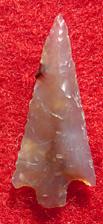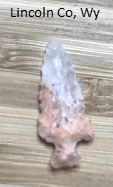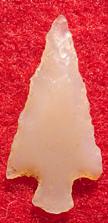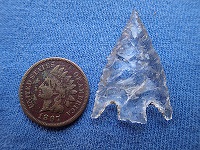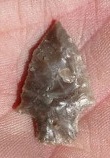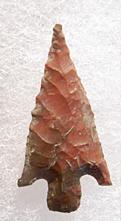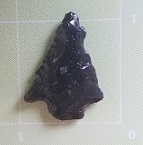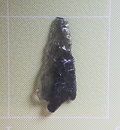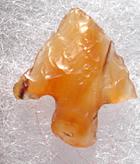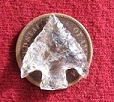Outline is Representative of Size and Shape:

Name Details:
Identified By: Robert F. Heizer and Martin A. Baumhoff
Named For: Type Site
Date Identified: 1961
Type Site: Rose Springs Site, Owens Valley, California
Identified By: Robert F. Heizer and Martin A. Baumhoff
Named For: Type Site
Date Identified: 1961
Type Site: Rose Springs Site, Owens Valley, California
Point Validity:
Valid type
Heizer was an eminent anthropologist and a professor at the University of California – Berkley. Heizer was instrumental in promoting our understanding of the archaeology of California and Nevada. Baumhoff was a distinguished anthropologist who served as Professor, Department Head, and Vice Chancellor Student Affairs at the University of California – Berkley. He conducted extensive studies into the archaeology of California. This type was named in a professional publication and has many professional references. This point is considered a valid type.
Heizer was an eminent anthropologist and a professor at the University of California – Berkley. Heizer was instrumental in promoting our understanding of the archaeology of California and Nevada. Baumhoff was a distinguished anthropologist who served as Professor, Department Head, and Vice Chancellor Student Affairs at the University of California – Berkley. He conducted extensive studies into the archaeology of California. This type was named in a professional publication and has many professional references. This point is considered a valid type.
Rose Springs Stemmed
AKA: Desert StemmedCluster: Rosegate Cluster
Description of Physical Characteristics and Flaking Pattern:
This is a narrow small triangular corner notch point with a flattened to narrow elliptical cross section. The blade is commonly thin and may vary from slightly excurvate to straight. The shoulders may vary from barbed to horizontal. The stem is most commonly slightly expanding, but may vary to straight. The base may range from straight to convex. This point has a random flaking pattern.
Size Measurements:
Total Length - 15 to 60 mm (average 20 to 30 mm), Stem Length - 4 to 8 mm, Blade Width - 8 to 17 mm, Stem Width - 4 to 8 mm, Thickness 3 to 6 mm
Total Length - 15 to 60 mm (average 20 to 30 mm), Stem Length - 4 to 8 mm, Blade Width - 8 to 17 mm, Stem Width - 4 to 8 mm, Thickness 3 to 6 mm
Commonly Utilized Material:
Additional Comments:
These point represent the first true arrow point and the transition to the bow and arrow technology in the Great Basin (Justice, 2002).
The Corner Notch, Side Notch, and Stemmed variation of this point may represent continuum of the same technology. The difference between the corner notch and side notch types may be the degree of re-sharpening of the blade which reduces the shoulder and notch placement in order to maximize the basal region. The stemmed variation commonly has a slightly expanding stem varies from the corner notch by the degree of expansion of the stem which may be a result of notching accident or the size and sharpness of the notching tool.
David H. Thomas (1981) combined the Rose Springs type and the Eastgate types into a single type due to the overlapping characteristics of the two types. He used a contracture of the two points and formed the Rosegate Cluster.
This point is similar to the Eastgate point, but this type lacks the square barbs typically seen on the Eastgate points. This point is usually narrower than the Eastgate points. Both types are the extension of the Elko Corner Notch type, but evolved to better fit the change in technology from the dart points to the arrow points. Desert series points and Cottonwood points replaced this type of point (Justice, 2002).
These point represent the first true arrow point and the transition to the bow and arrow technology in the Great Basin (Justice, 2002).
The Corner Notch, Side Notch, and Stemmed variation of this point may represent continuum of the same technology. The difference between the corner notch and side notch types may be the degree of re-sharpening of the blade which reduces the shoulder and notch placement in order to maximize the basal region. The stemmed variation commonly has a slightly expanding stem varies from the corner notch by the degree of expansion of the stem which may be a result of notching accident or the size and sharpness of the notching tool.
David H. Thomas (1981) combined the Rose Springs type and the Eastgate types into a single type due to the overlapping characteristics of the two types. He used a contracture of the two points and formed the Rosegate Cluster.
This point is similar to the Eastgate point, but this type lacks the square barbs typically seen on the Eastgate points. This point is usually narrower than the Eastgate points. Both types are the extension of the Elko Corner Notch type, but evolved to better fit the change in technology from the dart points to the arrow points. Desert series points and Cottonwood points replaced this type of point (Justice, 2002).
Distribution: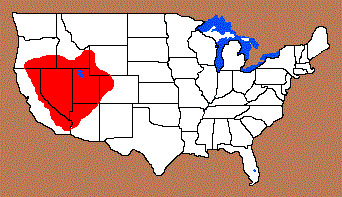
Distribution Comments:
This point is found through-out the Great Basin and into the northern Colorado Plateau. This point has a northern border of the Snake River Plain, an eastern border of the Colorado River valley, a western boarder of Death Valley and eastern California.
This point is found through-out the Great Basin and into the northern Colorado Plateau. This point has a northern border of the Snake River Plain, an eastern border of the Colorado River valley, a western boarder of Death Valley and eastern California.
Age / Periods:
Date: 1,500 - 700 B.P.
Cultural Period:Late Prehistory / Developmental
Glacial Period: Roman to Medieval Warm
Culture: Fremont and Anasazi Culture
Date: 1,500 - 700 B.P.
Cultural Period:Late Prehistory / Developmental
Glacial Period: Roman to Medieval Warm
Culture: Fremont and Anasazi Culture
Age Details:
Other points in this cluster / Related / Associated Points:
Eastgate Expanding Stem, Eastgate Split Stem, Parowan Basal Notch, Rose Springs Corner Notch, Rose Springs Side Notch, Rose Springs Sloping Shoulder, Rose Springs Stemmed
Eastgate Expanding Stem, Eastgate Split Stem, Parowan Basal Notch, Rose Springs Corner Notch, Rose Springs Side Notch, Rose Springs Sloping Shoulder, Rose Springs Stemmed


